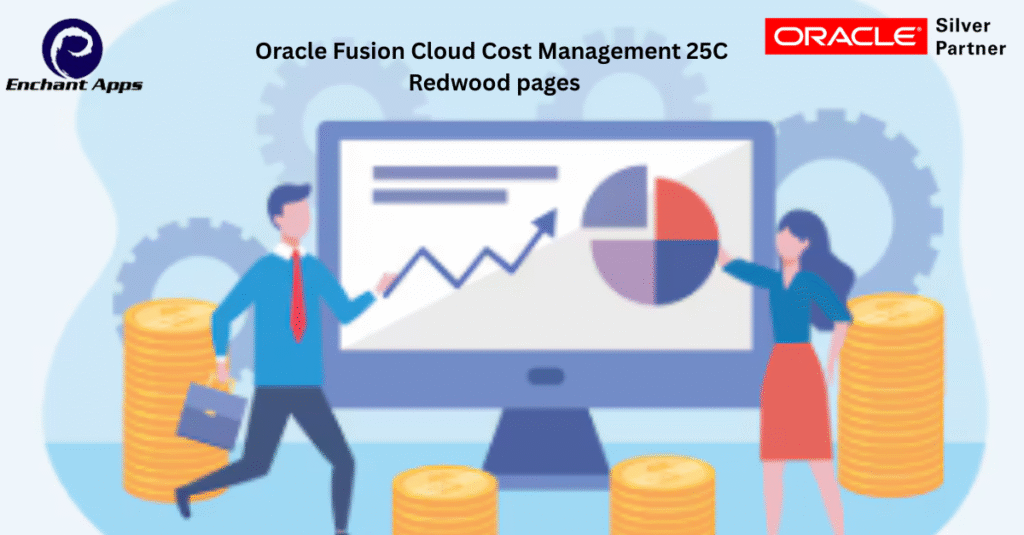The Redwood pages in Oracle Fusion Cloud Cost Management 25C, part of the Supply Chain
Management (SCM) suite, represent a significant evolution in user experience (UX) and
functionality. These pages are critical for organizations managing complex supply chain costing
processes, offering enhanced usability, efficiency, and integration with modern technologies
like AI. Below is a detailed explanation of their importance, tailored to the context of cost
management tasks such as cost books, valuation units, overhead expense pools, and more.

- Enhanced User Experience and Productivity
Intuitive Design: Redwood pages replace the classic UI with a modern, consumer-like interface
featuring simplified navigation, contextual actions, and responsive layouts. For example, the
Manage Cost Books page consolidates creation and editing into a single view, reducing clicks
and tab conflicts.
Guided Journeys: Pages like Cost Component Mappings and Trade Operation Templates include
embedded tutorials and AI-driven guidance (via the Costing Setup Assistant), helping
users—especially new ones—complete setups faster and with fewer errors.
Search and Bulk Actions: Pages such as Valuation Units and Item Cost Profiles offer advanced
search, filtering, and bulk editing capabilities, enabling faster data management for large
datasets.
Impact: These improvements reduce training time, minimize errors, and boost productivity for
cost accountants and supply chain managers handling repetitive or complex tasks.
- Streamlined Cost Management Processes
Simplified Setup: Redwood pages like Manage Overhead Expense Pools and Manage Cost
Books provide streamlined workflows for defining cost structures, such as allocating indirect
costs or setting up periodic average costing. This ensures accurate cost tracking and profitability
analysis.
Automation and Validation: The Valuation Units page supports auto-creation of units and
prevents edits after transactions, ensuring data integrity. Similarly, Trade Operation Templates
automate landed cost setups, reducing manual entry for shipment costing.
Impact: Faster, error-free setups lead to more reliable cost accounting, critical for organizations
with global supply chains or high transaction volumes.
- AI and Intelligent Automation Integration
Costing Setup Assistant: Introduced in 25C, this AI agent is embedded in Redwood pages,
providing real-time answers to setup questions (e.g., “How do I configure cost books?”) based
on Oracle’s official guides and user-specific templates. This reduces reliance on external
documentation or support.
Proactive Guidance: The assistant offers contextual suggestions during tasks like mapping cost
components or setting resource rates, improving decision-making and compliance with best
practices.
Impact: AI integration accelerates the adoption of Redwood pages, enhances accuracy, and
empowers users to handle complex costing scenarios without deep technical expertise.
- Future-Proofing and Deprecation Readiness
Transition from Classic UI: Oracle is phasing out classic pages, with Redwood becoming the
default for tasks like cost books and overhead expense pools. By 25C, most Redwood pages are
enabled by default, and classic versions will be deprecated in future releases (post-25C).
Extensibility: Redwood pages support customization via Visual Builder Studio, allowing
organizations to tailor interfaces to specific needs without disrupting upgrades.
Impact: Early adoption of Redwood pages ensures compliance with Oracle’s roadmap, avoiding
disruptions when classic pages are retired. It also positions organizations to leverage future
enhancements seamlessly.
- Improved Data Visibility and Decision-Making
Consolidated Views: Pages like Item Cost Profiles and Cost Component Mappings offer
spreadsheet exports, detailed column links, and filters by organization or cost book, making it
easier to analyze cost data.
Transparency: The Overhead Expense Pools page supports even cost spreading and detailed
allocation tracking, improving visibility into indirect costs for profitability reporting.
Impact: Enhanced data access and reporting capabilities enable better strategic decisions, such
as optimizing cost structures or identifying cost-saving opportunities in supply chains.
- Support for Global and Complex Operations
Multi-Organization Support: Redwood pages handle complex scenarios like inter-organization
transfers (via Cost Component Mappings) and global landed cost processing (via Trade
Operation Templates), critical for multinational enterprises.
Scalability: Pages are designed to manage high transaction volumes, with features like Oracle
Search Cloud Service (OSCS) integration for efficient data retrieval.
Impact: These features support organizations with diverse or distributed supply chains,
ensuring accurate costing across regions and entities.
EnchantApps Oracle Cloud experts can help you with your 25C Upgrade and testing. We are here to ensure that Oracle Cloud quarterly updates do not impact your business processes. Contact us for more details.
